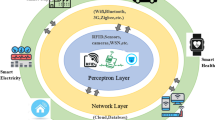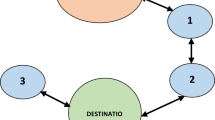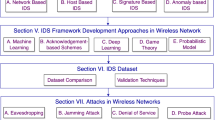Abstract
Nowadays, Mobile Ad hoc Networks (MANET) are utilized in numerous applications like disaster management, environmental monitoring, tactical operations, and so on. Usually, the MANET is processed in a wireless movable environment, so it has met several issues like insecurity, packet drop, high execution time, etc. In addition, malicious activities in the communication process have a severe impact on network channels. For that, a robust authentication protocol should be established to limit the attack and protect the data from malicious activities. In this article, a novel Data Integrity based Hash Protection (DIHP) algorithm is developed in Intermediate System to Intermediate System (IS-IS) protocol for securing the data transmission in MANET. In this proposed approach, primarily nodes are developed to transfer the data in the moving environment; hereafter, the encryption process is functioned to encrypt the data. If any attacks are tried to decrypt the data in the network channel, then immediately, the prevention parameter is initiated to prevent the attack. Thus, the data is secured from attacks and provides better communication by reducing the data flow rate. Moreover, the proposed DIHP approach is implemented in the Java platform, and the performance metrics are calculated. Also, the obtained results are validated with prevailing protocols and provide better outcomes. Consequently, the proposed DIHP method has attained 98.97bps throughput and 99.57% packet delivery ratio. Moreover, end-to-end delay is reduced as 2 s while compared with existing techniques. In addition, the developed DHIP has obtained a lower data rate and 0.12 ms transmission rate.













Similar content being viewed by others
References
Sarbhukan, V. V., & Ragha, L. (2020). Establishing secure routing path using trust to enhance security in MANET. Wirel Pers Commun, 110(1), 245–255. https://doi.org/10.1007/s11277-019-06724-0
Kumar, S. (2020). Prediction of node and link failures in mobile ad hoc network using hello based path recovery routing protocol. Wirel Pers Commun. https://doi.org/10.1007/s11277-020-07596-5
Ourouss, K., Naja, N., & Jamali, A. (2020). Defending against smart grayhole attack within MANETs: a reputation-based ant colony optimization approach for secure route discovery in DSR protocol. Wirel Pers Commun. https://doi.org/10.1007/s11277-020-07711-6
Josephine, J. A., & Senthilkumar, S. (2020). Tanimoto support vector regressive linear program boost based node trust evaluation for secure communication in MANET. Wirel Pers Commun. https://doi.org/10.1007/s11277-020-07209-1
Vatambeti, R. (2020). A novel wolf based trust accumulation approach for preventing the malicious activities in mobile ad hoc network. Wirel Pers Commun, 113(4), 2141–2166. https://doi.org/10.1007/s11277-020-07316-z
Boddu, N., Boba, V., & Vatambeti, R. (2021). A novel georouting potency based optimum spider monkey approach for avoiding congestion in energy efficient mobile ad-hoc network. Wirel Pers Commun. https://doi.org/10.1007/s11277-021-08571-4
Ellis J, Hertig CA, & Metscher R (2020) Concepts and Evolution of Asset Protection and Security. The Professional Protection Officer, Butterworth-Heinemann. (pp. 3–18). https://doi.org/10.1016/B978-0-12-817748-8.00001-8
Majeed, A., ur Rasool, R., Ahmad, F., Alam, M., & Javaid, N. (2019). Near-miss situation based visual analysis of SIEM rules for real time network security monitoring. J Ambient Intell Humaniz Comput, 10(4), 1509–1526. https://doi.org/10.1007/s12652-018-0936-7
Simpson, S. V., & Nagarajan, G. (2020). SEAL—security-aware list-based routing protocol for mobile ad hoc network. Int Conf Emerg Trends Adv Electr Eng Renew Energy, Springer, Singap. https://doi.org/10.1007/978-981-15-7504-4_51
Moradipour, O., & Fathi, M. (2020). An anti-gray hole attack scheme in mobile ad hoc network. Int J Wirel Inform Netw, 27(4), 558–567. https://doi.org/10.1007/s10776-020-00492-6
Parham, M., & Pouyan, A. A. (2020). An effective privacy-aware Sybil attack detection scheme for secure communication in vehicular ad hoc network. Wirel Pers Commun, 113(2), 1149–1182. https://doi.org/10.1007/s11277-020-07272-8
Kshirsagar, V. H., Kanthe, A. M., & Simunic, D. (2018). Trust based detection and elimination of packet drop attack in the mobile ad-hoc networks. Wirel Pers Commun, 100(2), 311–320. https://doi.org/10.1007/s11277-017-5070-x
Stylianopoulos, C., Almgren, M., Landsiedel, O., & Papatriantafilou, M. (2020). Multiple pattern matching for network security applications: acceleration through vectorization. J Parallel Distrib Comput, 137, 34–52. https://doi.org/10.1016/j.jpdc.2019.10.011
Boche, H., Schaefer, R. F., Baur, S., & Poor, H. V. (2019). On the algorithmic computability of the secret key and authentication capacity under channel, storage, and privacy leakage constraints. IEEE Trans Signal Process, 67(17), 4636–4648. https://doi.org/10.1109/TSP.2019.2929467
Manjula, T., & Anand, B. (2019). A secured multiplicative Diffie Hellman key exchange routing approach for mobile ad hoc network. J Ambient Intell Humaniz Comput. https://doi.org/10.1007/s12652-019-01612-8
Elmahdi, E., Yoo, S. M., & Sharshembiev, K. (2020). Secure and reliable data forwarding using homomorphic encryption against blackhole attacks in mobile ad hoc networks. J Inform Secur Appl, 51, 102425. https://doi.org/10.1016/j.jisa.2019.102425
Kumar, S. (2020). Prediction of node and link failures in mobile ad hoc network using hello based path recovery routing protocol. Wirel Pers Commun, 115(1), 725–744. https://doi.org/10.1007/s11277-020-07596-5
AlRubaiei, M., Jassim, H., Sharef, B. T., Safdar, S., Sharef, Z. T., & Malallah, F. L. (2020). Current vulnerabilities, challenges and attacks on routing protocols for mobile ad hoc network: a review. Swarm Intell Resour Manage Internet Things. https://doi.org/10.1016/B978-0-12-818287-1.00012-7
Guo, Z., Zhang, X., & Zhao, B. (2019). A memory-reinforced tabu search algorithm with critical path awareness for HW/SW partitioning on reconfigurable MPSoCs. IEEE Access, 7, 112448–112458. https://doi.org/10.1109/ACCESS.2019.2934390
Mohammad SN, Singh RP, Dey A, & Ahmad SJ (2019) ESMBCRT: Enhance Security to MANETs Against Black Hole Attack Using MCR Technique. Innovations in Electronics and Communication Engineering, Singapore, Springer. (pp. 319–326). https://doi.org/10.1007/978-981-10-8204-7_32
Furqan HM, Sidhu GAS, & Arslan H (2019) User Association for Enhancing Physical Layer Security in Heterogeneous Network. International Telecommunications Conference, Springer, Singapore. https://doi.org/10.1007/978-981-13-0408-8_19
Yang, C. T., Chen, S. T., Liu, J. C., Yang, Y. Y., Mitra, K., & Ranjan, R. (2019). Implementation of a real-time network traffic monitoring service with network functions virtualization. Future Generation Computer Systems, 93, 687–701. https://doi.org/10.1016/j.future.2018.08.050
Aghili, H. (2019). Improving Security Using Blow Fish Algorithm on Deduplication Cloud Storage (pp. 723–731). Springer, Singapore: Fundamental Research in Electrical Engineering.
Elhoseny, M., & Hassanien, A. E. (2019). An Encryption Model for Data Processing in WSN (pp. 145–169). Springer, Cham: Dynamic Wireless Sensor Networks.
Islabudeen, M., & Devi, M. K. K. (2020). A smart approach for intrusion detection and prevention system in mobile ad hoc networks against security attacks. Wirel Pers Commun. https://doi.org/10.1007/s11277-019-07022-5
Howser, G. (2020). Service Provider Protocols (pp. 299–319). Springer, Cham: Computer Networks and the Internet.
Puthal, D., Wu, X., Nepal, S., Ranjan, R., & Chen, J. (2017). SEEN: a selective encryption method to ensure confidentiality for big sensing data streams. IEEE Trans Big Data. https://doi.org/10.1109/TBDATA.2017.2702172
Jolly, P. K., & Batra, S. (2019). Security against attacks and malicious code execution in mobile agent using IBF-CPABE protocol. Wirel Pers Commun. https://doi.org/10.1007/s11277-019-06329-7
Vo, T. T., Luong, N. T., & Hoang, D. (2019). MLAMAN: A novel multi-level authentication model and protocol for preventing wormhole attack in mobile ad hoc network. Wirel Netw, 25(7), 4115–4132. https://doi.org/10.1007/s11276-018-1734-z
Elhoseny, M., & Shankar, K. (2019). Reliable data transmission model for mobile ad hoc network using signcryption technique. IEEE Trans Reliab, 69(3), 1077–1086. https://doi.org/10.1109/TR.2019.2915800
Author information
Authors and Affiliations
Corresponding author
Ethics declarations
Conflict of interest
The authors declare that they have no potential conflict of interest.
Ethical Approval
All applicable institutional and/or national guidelines for the care and use of animals were followed.
Informed Consent
For this type of study formal consent is not required.
Additional information
Publisher's Note
Springer Nature remains neutral with regard to jurisdictional claims in published maps and institutional affiliations.
Rights and permissions
About this article
Cite this article
Kumar, S. Security Enhancement in Mobile Ad-Hoc Network Using Novel Data Integrity Based Hash Protection Process. Wireless Pers Commun 123, 1059–1083 (2022). https://doi.org/10.1007/s11277-021-09170-z
Accepted:
Published:
Issue Date:
DOI: https://doi.org/10.1007/s11277-021-09170-z




